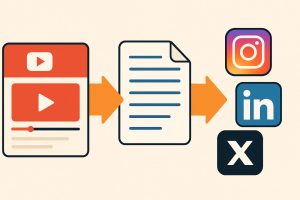Building a Time-Saving System
For many content creators and small businesses, creating social media posts daily can become a repetitive task. A lot of time is wasted thinking about what to post, how to design it, and when to publish. In this scenario, building reusable content templates becomes a simple yet powerful way to streamline and speed up the entire process.
Reusable content templates act like design frameworks that can be used repeatedly. Once you have a template, there’s no need to start from scratch each time. You just need to update the content—swap out the text, image, or colors—while keeping the overall style and layout intact. This simplifies the workflow and shortens turnaround time.
Beyond speed, there’s the added benefit of consistency. When your posts have a uniform look, they become more familiar to your audience. It’s easier for people to recognize your brand, even if they’re just quickly scrolling. A consistent style tends to stick in people’s minds.
Better Content Planning
With reusable templates, it becomes easier to plan content for a week or even a month. You won’t run out of ideas because you have a structure to follow. The visual style is already there—you just have to fill it in with the right message.
For example, one template can be for a “tip of the day,” another for “product highlights.” In a week, you can use three different templates, each with its own purpose. This allows you to deliver a balanced content mix—offering value, promoting products, and entertaining your audience.
A good template system also brings clarity to your team. If you have a designer, they know they don’t need to reinvent the wheel for every post. If you’re a solo creator, content creation becomes easier to slot into your busy schedule.
Visual Consistency Across Platforms
Visual consistency isn’t just about making your feed look good. It’s one of the keys to strong brand recall. When audiences see the same fonts, colors, and layouts across platforms—Instagram, Facebook, LinkedIn—they remember your brand more easily.
Some brands are so consistent that you recognize their content even without seeing their name. Maybe it’s the filter, the border, or the layout they always use. This is the effect of visual patterning. Over time, audiences develop a mental shortcut: one glance and they know it’s your content.
Reusable templates make this easier to achieve. You don’t have to worry if your branding is consistent. If your template structure stays the same in every post, visual unity becomes automatic. Even if colors or headlines change, the message still clearly comes from you.
Easier Content Updates
One of the key benefits of templates is flexibility. If you need to update something—like prices, new features, or event details—you don’t have to create a new design. Just change the content inside the template, and you’re done.
For instance, if you have a sales announcement now and another next week, you can use the same layout with different products. No need to re-brief your designer or make a new mockup. One template, updated content, fast delivery.
This kind of system reduces stress, especially during tight deadlines. You won’t panic if a sudden post is needed. With templates, you have a ready-to-use format. It helps keep your online presence consistent and reliable.
Less Daily Content Fatigue
Daily content creation can lead to burnout, especially if you’re a one-person team. Without a system, every post feels like starting over. But with templates, you already have a base—you just need to finish it.
For example, you might use four main templates in a month: quote format, promo banner, how-to tip, and Q&A layout. This not only simplifies the process but also brings mental clarity. You instantly know what type of content to publish and when.
With this kind of structure, the effort becomes lighter. You won’t have to spend two hours making an Instagram story. You’ll have more time for other things—like customer service, planning, or simply resting.
More Room for Creative Freedom
Even though templates are repetitive, that doesn’t mean creativity is lost. In fact, having a defined format sharpens your focus. Since you’re no longer thinking about layout, you can play more freely with the content, tone, and visuals.
For example, a “weekly tip” template can have different colors depending on the season—bright for summer, muted for the rainy season. This is how you stretch your creativity while maintaining structural consistency.
You don’t have to feel boxed in. A template is a guide, not a wall. When you know where to begin, it’s easier to come up with more meaningful ways to deliver your message. That’s where real creative confidence kicks in.
Helps with Better Performance Analysis
With templates, it’s easier to measure which formats are most effective. Because your posts follow the same style, you can quickly see which ones get the most engagement, clicks, or shares. The result: better-informed content strategy.
For example, you might notice that the tip-based template gets more saves than the promotional layout. That insight shows what type of content you should prioritize next month. The comparison is more objective because the visual treatment is consistent.
Data becomes cleaner when the format is consistent. You don’t have to guess at variables. And because analysis becomes easier, you can make faster, data-driven decisions. This is where creative and strategic goals intersect.
Enhances Team Collaboration
If you have a team—even if it’s just two of you—templates create a shared understanding. You both follow the same base format, so there’s no confusion about style, color, or tone. The output becomes more aligned.
For example, if you have a social media manager and a designer, the feedback loop shrinks. With a template in place, both know the expected outcome. Content is produced faster with fewer revisions.
Templates also make onboarding new team members easier. They have a guide to follow, no need to guess the workflow. This allows your content production to grow without compromising quality.
Delivers Clearer Messaging
When layouts are standardized, the message itself stands out more. The viewer’s eyes aren’t distracted by design changes. The idea becomes more memorable because it’s not lost in too many visual elements. The simplicity of the template allows the idea to shine.
For instance, if your goal is to post a short tutorial, it helps to have a uniform structure for each step. You don’t need to change the layout each time. This way, your audience can understand the lesson more easily.
Template consistency goes beyond visuals. The tone, format, and flow become familiar. That makes it easier for the audience to follow, understand, and return to your content in the future.
Keeps Your Brand Present Even When You’re Busy
The final benefit of reusable content templates is that they keep your brand active even when you’re busy. You don’t need to be online constantly to publish content. With templates, you can prepare and schedule posts in batches.
One creator sets aside one day each month to create 20 posts using templates. The content is scheduled for the entire week. No burnout. And the audience still sees regular updates.
Templates are like your brand’s support system. They quietly do the work behind every post. That frees you to focus on bigger things—like engaging your audience or reaching higher goals.
Makes Your Brand Easier to Recognize
The long-term effect of reusable templates is brand recognition. When used consistently, the look, tone, and format of your content become familiar to your audience. Even during a quick scroll, they’ll recognize, “This is the brand I follow.”
The simple format becomes your visual identity. It doesn’t have to be flashy or overly creative. As long as it’s consistent and purposeful, it becomes recognizable to the eye. And where there is familiarity, trust and loyalty soon follow.
This doesn’t mean you can’t change. But change guided by templates is easier for your audience to adapt to. In the end, reusable content templates offer a system that’s simple yet powerful—quiet in presence, but felt in every post.











No responses yet